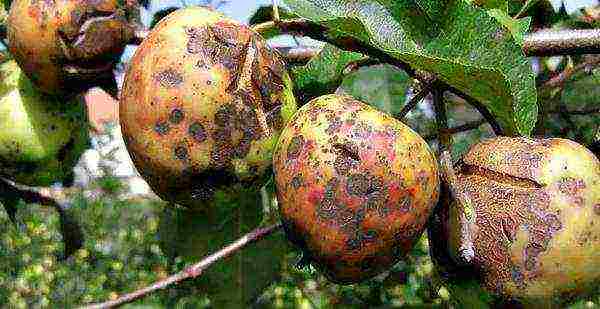Content [show]
Low-growing apple trees attract gardeners with their compactness, high yield and resistance to diseases. And if the size of the site is small, then there is no better option for organizing a mini-garden.
Usually, an apple tree is represented as a tall and mighty tree with a spreading crown, which casts a shadow over almost half of the area. However, the apple tree reaches this size by the age of 15-20, and even then not always. Even within the same variety, an apple tree can grow, or it can remain a dwarf tree. It turns out that the "growth" of a tree depends on rootstock... It acts as the foundation of the future apple tree, its choice affects the duration of the productive period of the tree, the timing of its entry into the fruiting and ripening phases, the taste, appearance and size of the fruits, as well as the duration of their storage.
The cultivar of the apple tree can be grafted onto a vigorous or dwarf stock. Depending on this, the tree will also be either tall, with a massive crown, or stunted, supported by a trellis. However, there are varieties that are natural "dwarfs", i. E.even on an ordinary rootstock, their height does not exceed 3 m. Some of the most popular are the following varieties of dwarf apple trees.
Bratchud
The full name of this winter variety sounds like "Brother of the Wonderful", it is suitable for cultivation in all climatic zones. The tree is a natural "dwarf" with a flat-rounded crown up to 3 m in diameter. Fruit size usually does not exceed average values. Their distinguishing feature is the presence of a small seam in the form of a strip. The skin is dry, with a glossy sheen. The main color of the fruit is greenish-yellow, later a crimson blush appears. The pulp of ripe fruits is white, coarse-grained. It cannot be called juicy, but the taste remains pleasant. The variety is high-yielding, transportable, with a long shelf life.
| Entering fruiting | Tree height (m) | Fruit weight (g) | Harvest | Shelf life (days) | |
|
3-4 years |
1,5-2 |
140-160 |
End of September |
120-140 | |
Carpet
Autumn variety of apples. The crown of the tree is horizontal, drooping. The size of the fruits exceeds the average size and can reach 200 g. The fruits are flat-rounded, their main color is greenish-yellow, subsequently saturated with a red blush. The pulp is creamy, coarse-grained and slightly juicy, moderately aromatic, with a pleasant sweet and sour taste. The variety has a stable high yield. During a long winter, the lower branches can break off under the weight of the snow.
| Entering fruiting | Tree height (m) | Fruit weight (g) | Harvest | Shelf life (days) | |
|
3-4 years |
1,5-2 |
150-170 |
End of September - beginning of October |
50-60 | |
Legend
Early winter grade. A tree with a dense spherical crown and compactly spaced shoots. The fruits are slightly ribbed, grow rather large, resemble a truncated cone in shape. The main color of apples is greenish with a yellow tint; as they ripen, the fruits turn red. Occasionally, burgundy stripes appear on their surface. The pulp is white, with a creamy shade, juicy, fine-grained with a strong aroma. The taste of the fruit is sweet, caramel. The advantages of the variety are frost resistance and immunity to most pests and diseases.
| Entering fruiting | Tree height (m) | Fruit weight (g) | Harvest | Shelf life (days) | |
|
2-3 years |
2-3 |
180-200 |
Early October |
60-90 | |
Moscow red
High-yielding winter variety. The tree is not tall with a compact spherical crown. Fruits are round in shape, without ribs. The main color of the fruit is greenish-yellow; as it ripens, it acquires a bright yellow tint. By the time the fruit is picked, a deep red blush appears on the surface. The pulp is yellowish, with a pleasant sweet and sour taste. The variety is resistant to scab and other diseases, fruits and leaves remain healthy throughout the entire ripening period.
| Entering fruiting | Tree height (m) | Fruit weight (g) | Harvest | Shelf life (days) | |
|
For 6-7 years |
2-3 |
130-190 |
End of September - beginning of October |
90-120 | |
Stunted
Trees are undersized, branches grow at right angles to the trunk. Fruits are medium in size, round in shape, with large, well-visible ribs. The color of the fruits is greenish-yellow; as they ripen, red stripes appear on their surface, merging into a solid blush. The pulp is greenish in color, dense, fine-grained, juicy, with a sour-sweet aftertaste. The variety is winter-hardy, fast-growing, high-yielding. However, in a rainy summer, the leaves are affected by scab.
| Entering fruiting | Tree height (m) | Fruit weight (g) | Harvest | Shelf life (days) | |
|
3-4 years |
1,5-2 |
130-150 |
Second half of September |
120-150 | |
Snowdrop
Shale apple tree with predominantly horizontal branches. Young trees bear fruit almost every year. The fruits are medium in size, although there are specimens weighing 300 g. Their shape is rounded-conical with small ribs. The main color of the fruits is light yellow, later they are covered with a dark red blush. The pulp is light white, very juicy and tasty.The fruits are consumed both fresh and used for making jams, preserves and compotes. The consumption and removable ripeness of apples coincide, so they can be consumed immediately after picking.
| Entering fruiting | Tree height (m) | Fruit weight (g) | Harvest | Shelf life (days) | |
|
3-4 years |
1,5-2 |
140-170 |
Beginning of September |
100-120 | |
Grounded
The branches of the tree during the growth period begin to grow horizontally, almost parallel to the ground, while their ends are bent upward. Fruits are regular and round in shape, their size is slightly less than average. The main color of the apple is greenish-yellow; as it ripens, a red blush appears, which occupies the entire area of the apple. The pulp is greenish, firm, very juicy and rich. The fruit tastes sweet and sour, suitable for making jams and preserves. The tree can withstand frosts down to -40 ° C, and bears fruit annually.
| Entering fruiting | Tree height (m) | Fruit weight (g) | Harvest | Shelf life (days) | |
|
2-3 years |
1,5-2 |
90-110 |
September |
50-60 | |
Early sweet
Low-growing tree with a flat-rounded crown. Bears fruit annually. Fruits are flat-round and medium in size. The main color is light yellow. The pulp is white and sweet, with a slight creamy undertone. Winter hardiness and scab resistance are very high.
| Entering fruiting | Tree height (m) | Fruit weight (g) | Harvest | Shelf life (days) | |
|
3-4 years |
1,5-2 |
90-100 |
Early august |
10-15 | |
Sokolovskoe
Winter variety, bred relatively recently. Fruits are larger than medium in size, flat-rounded. The shiny peel is usually greenish-yellow in color; as it ripens, the apple is covered with an expressive dark red blush. The pulp is creamy, dense and juicy, fine-grained. The taste of the fruit is sweet and sour with a pleasant aftertaste. They are consumed fresh and used to make jams, preserves and compote. The Sokolovskoe variety is a natural "dwarf" with high productivity, but insufficient resistance to summer heat and frost.
| Entering fruiting | Tree height (m) | Fruit weight (g) | Harvest | Shelf life (days) | |
|
3-4 years |
1-1,5 |
170-190 |
October |
100-110 | |
Sun
A late autumn variety with immunity to scab, bred over 20 years ago. The crown is rounded, not very thickened. Fruits grow within medium size, oblong-beveled shape, smooth and oily skin. The main color of the fruits is greenish-yellow, as they ripen, they turn yellow, and a raspberry blush appears on them. The pulp is white, with rare creamy splashes, juicy and dense. Apples have a sweet and sour taste with a rich aftertaste. Winter hardiness and productivity of the variety are high.
| Entering fruiting | Tree height (m) | Fruit weight (g) | Harvest | Shelf life (days) | |
|
3-4 years |
1,5-2 |
140-160 |
Second half of September |
90-120 | |
Wonderful
The tree is undersized (natural "dwarf"), the crown is formed in a horizontal plane, almost creeping along the ground. The fruits are large, more than average in size, the weight of some reaches 200 g. The shape of the apples is flat-rounded, the main color is yellow-green, as it ripens, a rich bright red blush appears. The pulp of the fruit is juicy, with a fine-grained structure, sour-sweet taste, with a pleasant aftertaste. The variety is characterized by increased winter hardiness and scab resistance.
| Entering fruiting | Tree height (m) | Fruit weight (g) | Harvest | Shelf life (days) | |
|
2-3 years |
1,5-2 |
120-140 |
Early august |
25-30 | |
How dwarf apple trees differ from the rest
The differences between tall and dwarf trees become noticeable even at the stage of choosing one or another seedling. When buying, dwarf seedlings can be distinguished by their appearance. For example, along large buds at the ends of branches or a fibrous root system with small roots. Tall apple trees, by comparison, have a rod-shaped root system.
The roots of dwarf apple trees are shallow, so such trees can be planted in areas with a groundwater level above 1-1.5 m.
In the garden, dwarf apple trees are always easy to distinguish by their compact size, neat crown and regular fruiting. These trees reach a height of 2-3 m and begin to produce crops already in the third year.
Are dwarf and columnar apple trees the same thing?
Columnar apple trees are often confused with dwarf ones. However, these are two different forms of fruit trees. Dwarf apple trees are short trees with a spreading crown that can reach a diameter of 3 m. Columnar apple trees have a well-defined trunk with short lateral branches. In shape, it resembles a column, in the upper part and along which fruits grow. In order not to be mistaken when choosing a seedling, pay attention to the following signs:
- a columnar apple tree grows in one trunk, practically without lateral branches;
- the root system of a dwarf apple tree is fibrous (in a columnar one it is pivotal), the more elastic it is, the healthier the tree.
Dwarf apple varieties are intended for small areas with a close location of groundwater. They take up little space, quickly bear fruit and give a bountiful harvest. The fruits of low-growing apple trees are stored for a rather long time, have a marketable appearance and have a pleasant taste and aroma. Be sure to plant them in your garden to appreciate all the benefits of plants.
 Recently, more and more attention of gardeners is focusing on dwarf apple varieties, which, of course, have a number of advantages over the classic varieties of apple trees... They are:
Recently, more and more attention of gardeners is focusing on dwarf apple varieties, which, of course, have a number of advantages over the classic varieties of apple trees... They are:
- take up less space in the garden;
- tolerate winter better;
- harvesting is much more convenient;
- as well as caring for them.
To choose the right variety of this type of apple tree, you need to understand what are the nuances in caring for themwhat to avoid, what to be prepared for and how to create the best possible conditions for growing them.
general characteristics
 Dwarf apple trees are considered, the height of which does not exceed 2.5, and the root system has a fibrous structure, which is located in a meter layer of soil.
Dwarf apple trees are considered, the height of which does not exceed 2.5, and the root system has a fibrous structure, which is located in a meter layer of soil.
This fact is used by gardeners, in an area with a close occurrence of groundwater, which can damage the deep-lying roots of trees.
All varieties of dwarf apple trees can be divided into groups, depending on when the fruits fully ripen:
- summer type;
- autumn type;
- winter type.
Dwarf apple varieties
Candy
Very early ripening variety, apples ripen in the first week of August. The apple tree is distinguished by its excellent quality, fragrant round-shaped fruits, covered with a rich green skin and strong crunchy flesh. Average fruit weight 125 g.
Candy perfectly tolerates frost and sudden changes in temperature.
Important! If frosts nevertheless damage the aboveground part of the tree, then it tends to recover very soon and resume fruiting.

Candy.
Read more about the Candy apple in this article.
Melba
It is a popular, widespread variety withThe first among dwarf varietiesrecognized by breeders.
Attracts gardeners with its early maturity (The 1st crop can be removed in the 3rd year after planting), excellent yield (up to 145 - 150 kg of fruits per tree) and unpretentiousnesshowever it is worth noting average resistance to scab pathogens and severe frosts.
Apples ripen in the first half of August, medium-sized fruits (average weight 155 g), rounded in shape, covered with a delicate skin, on which is a raspberry blush.
Inside, the fruit is snow-white, tender, pleasant in structure, very aromatic.The taste is sweet, with a special caramel aftertaste.
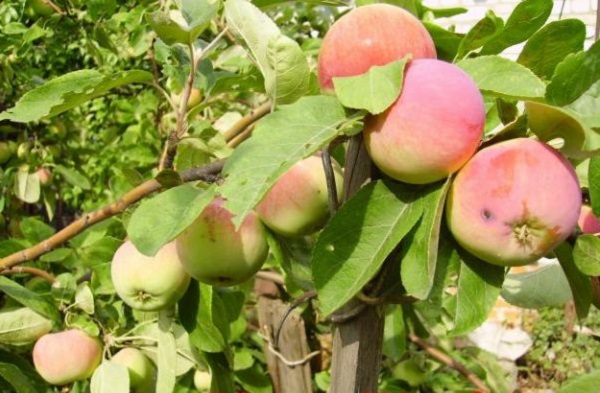
Melba.
You can find out more about the Melba apple tree here.
Moscow necklace
Enough new variety, instantly loved by fruit growers for its large tasty apples, which reach full maturity in October and early maturity: the primary harvest can be seen as early as the 3rd year after the tree is placed on the site. The apple tree is resistant to the scab pathogen, tolerates frost well.
Fruit:
- enlarged, leveled, average weight - 173 g;
- spherical regular shape;
- covered with a loose skin of a wine-red color;
- have an amazing aroma, fragile and juicy structure;
- The taste is sweet and sour, with an unobtrusive sourness.
After harvest can be stored for up to 100 days.
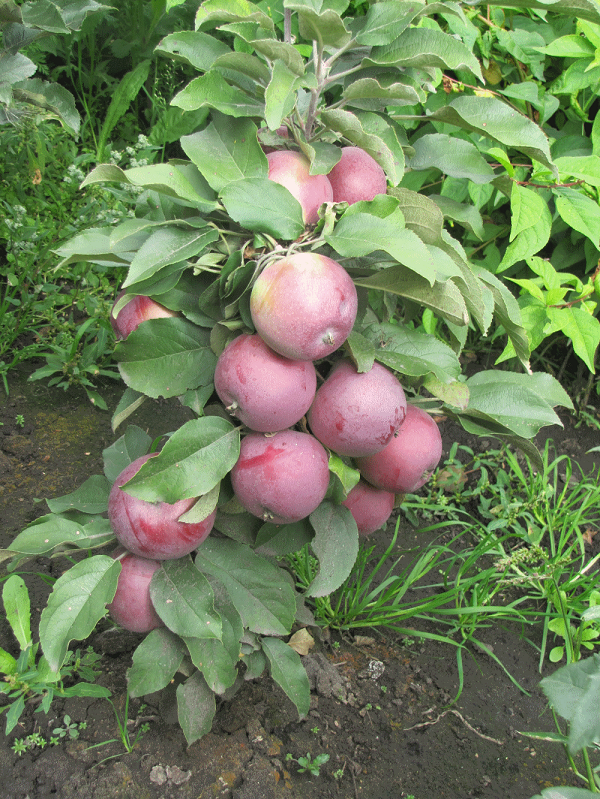
Moscow necklace.
You can read more about the Moscow necklace apple tree here.
Wonderful
The height of a tree of this variety - from 1.6 to 2 m, depending on the type of rootstock, the crown is sweeping, with falling branches dropping even lower under the weight large fruits (average weight 210 g).
Fruits are spherical, slightly flattened in the center, aligned, covered with a thin yellow-green skin. Apple has classic dessert taste, with a barely noticeable sourness, pleasant consistency.
Important! One of the most important advantages of this variety is that the apple tree perfectly tolerates stagnant water.

Wonderful.
You will learn more about the Chudnoye variety from this article.
Sokolovskoe
Belongs to the category natural dwarfs, its height is 1.1 - 2 m, fruiting irregular, begins in the 4th year after planting. Productivity 55 -65 kg per tree.
The fruits are flattened-spherical, covered with a delicate but dense glossy dry skin of a yellowish hue, which by the time of ripening is covered with large raspberry strokes. Under the skin the apple is granular, dense, cream-colored, aromatic, with a sweet and sour taste.
Average winter hardiness, too cold temperatures in winter can damage the fruit buds. Prolonged drought in summer negatively affects the taste characteristics of apples.
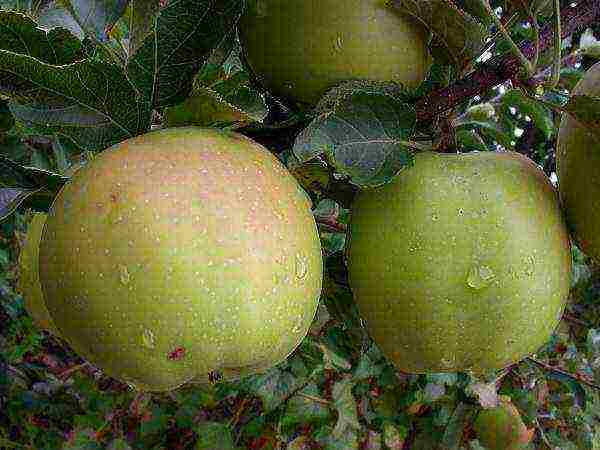
Sokolovskoe.
Read more about the Sokolovskoye apple in this article.
Zhigulevskoe
Stunted tree, very quickly entering the fruiting period, the fruits are ready for harvest in September, have a round shape. Covered from above with a dense thin skin of a yellow-green hue, by the time of full ripeness it is covered with crimson vertical streaks.
Excellent taste characteristics, the yield tends to increase from year to year.
The variety is resistant to pathogens of fungal diseases and the influence of pests, winter hardiness is above average.
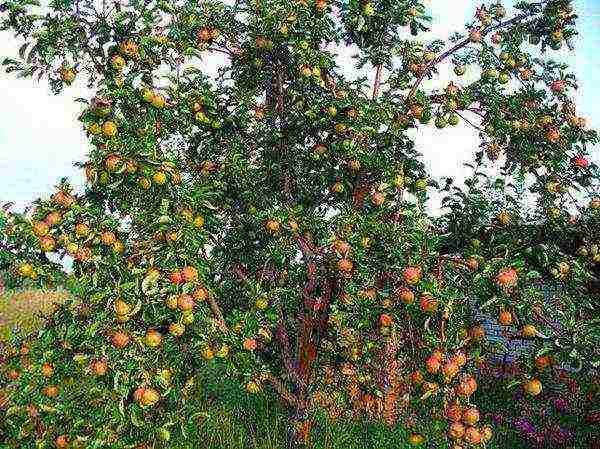
Zhigulevskoe.
You can find out more about the Zhigulevskoye apple tree here.
Snowdrop
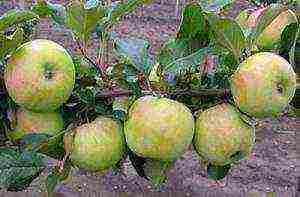 This variety of apples - genetic dwarfs, reaches a height of 1.5 m, refers to stanza... It is very fast-growing, the first harvest can be removed 3 years after planting.
This variety of apples - genetic dwarfs, reaches a height of 1.5 m, refers to stanza... It is very fast-growing, the first harvest can be removed 3 years after planting.
The yield is high, but over time, an implicit periodicity may appear.
High drought tolerance and frost tolerance, the apple tree is able to withstand low temperatures down to -40 ° C.
Fruit:
- medium by weight, which varies from 135 g to 173 g;
- rounded-elongated shape;
- the top of the apples is covered with a thin peel, dry and smooth, of a pale yellow hue with raspberry-pink strokes along the perimeter of the fruit;
- apple pulp is juicy and crunchy, sweet and sour, aromatic.
The fruits are ready to be harvested in early September, universal in appointment, can be stored for up to four months.
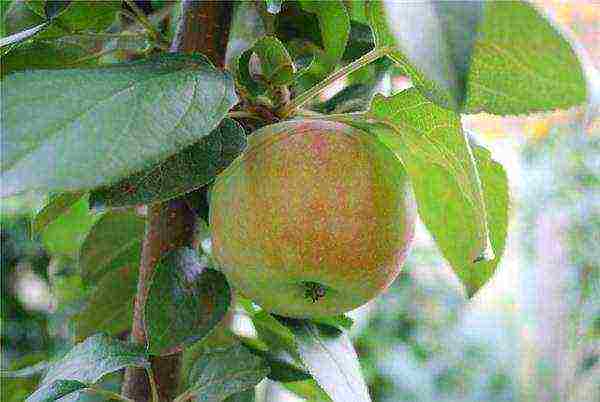
Snowdrop.
You can read more about the Snowdrop apple tree here.
Carpet
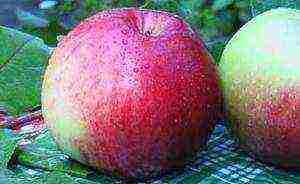 Autumn undersized tree, recommended for cultivation in the Ural and West Siberian regions, possesses tremendous frost resistance and resistance to the influence of pathogens of fungal diseases.
Autumn undersized tree, recommended for cultivation in the Ural and West Siberian regions, possesses tremendous frost resistance and resistance to the influence of pathogens of fungal diseases.
Carpet is distinguished by its early maturity, the first harvest should be expected after 3-4 years after grafting, the yield is high (64 kg per tree), but over time periodicity can be observed.
The fruits are enlarged, the average weight is 155 - 160 g, have a spherical, slightly flattened shape, covered with a soft, delicate skin of a yellow-light green color, with a bright scarlet blush.
The inside is dryish, with active grain, beige.
The purpose of the crop is processing and fresh consumption.
Apples can be stored in a cool place for up to one and a half months.
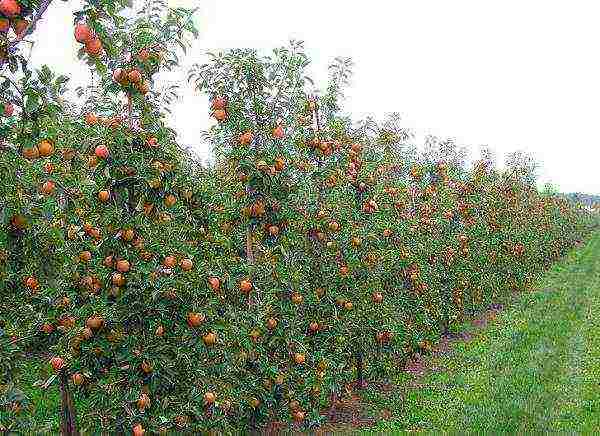
Carpet.
You will learn more about the Carpet variety from this article.
Bratchud
The apple tree of the Chelyabinsk selection belongs to the natural elfin. The apple tree is medium-late (collection - mid-September), the fruits are medium (145 - 165 g), round, slightly elongated with an implicit ribbing. The peel is smooth, glossy, dry, olive green with an unobtrusive blush.
Inside apple with an active white shade, medium-grained, not juicy, sour-sweet taste with a pleasant aroma. Fruits can be stored for up to 4 months, transportability is satisfactory.
Variety stands out for its resistance to frost. Among the shortcomings, it is worth highlighting the weak resistance to scab pathogens.

Bratchud.
Read more about the Bratchud apple tree in this article.
Grounded
Large-fruited early ripening variety, characterized by an excellent yield (up to 135 kg from an apple tree), the first harvest can be obtained three years after planting the tree in the ground.
Fruits are large, average weight 145 g, spherical shape. The apple is covered with a dense thin fragrant green peel, by the time of ripeness it becomes covered with a beautiful even blush, the taste is sweet and sour, which has received a high tasting rating.
Important! This variety has excellent scab resistance and high frost resistance.

Grounded.
You can find out more about the landed apple here.
Legend
This the variety of undersized baby apple trees is early winter (collection can be carried out from the beginning of October), enters the fruiting phase in the 3rd year after planting in the garden.
Fruits are slightly ribbed, round, somewhat elongated, the main color of a strong thin skin is light green-yellow, the integumentary color is bright crimson with thick burgundy vertical stripes. Inner part juicy, white with creamy splashes, with a distinct apple smell and dessert taste. Fruit weight can vary from 175 g to 200 g.
After harvest can be saved for 90 days.
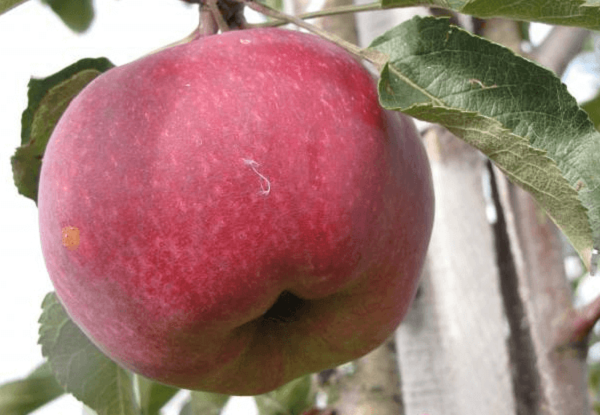
Legend.
You can read more about the Legend apple tree here.
Moscow red
Variety with excellent yield, late fruiting (the crop is harvested in the first decade of October), it is highly resistant to scab pathogens and other diseases, winter hardiness and frost resistance are satisfactory.
The fruits are smooth, round, the peel is strong, but thin, green; by the time of ripening, a crimson continuous blush appears on the side. The weight of apples is 135 - 185 g.
After ripening and picking apples can be stored for up to 120 days.
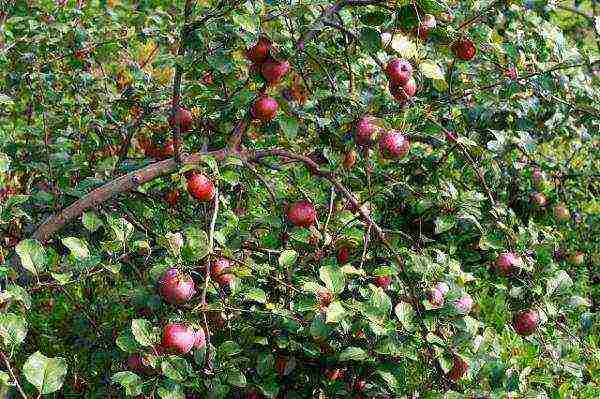
Moscow red.
Stunted
The variety is recommended for cultivation in the Central Black Earth zone, fast-growing, frost-resistant.
Important! A significant disadvantage is that the Stunted in a rainy summer can be infected
scab
.
The fruits of this apple tree are round, slightly flattened in the center, medium-sized, covered with a smooth glossy skin of a yellow-green hue. By the time the hearth is removed, it is covered with wide crimson stripes almost along the entire perimeter of the apple.
The flesh is crunchy, dense, sourish and very juicy with a white-green hue with a classic apple scent.
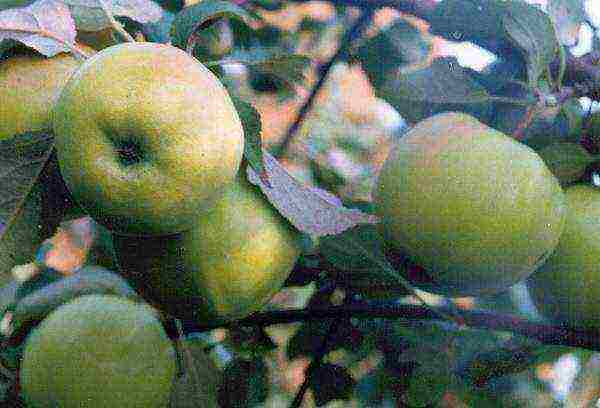
Stunted.
Read more about the Low-growing apple tree in this article.
Sun
This variety is late autumn (harvested towards the end of September), distinguished by immunity to scab pathogens, excellent frost resistance and quite satisfactory yield.
Fruits are medium-sized in size (145 g), elliptically oblique, aligned, covered with a strong oily skin of a green-yellow color, which by the time of maturity is covered with a bright continuous scarlet blush.
The taste is unobtrusive, sweet and sour with a pleasant fresh fruity aftertaste.Inside, the apple is dense, homogeneous, juicy, snow-white, with a pleasant aroma.
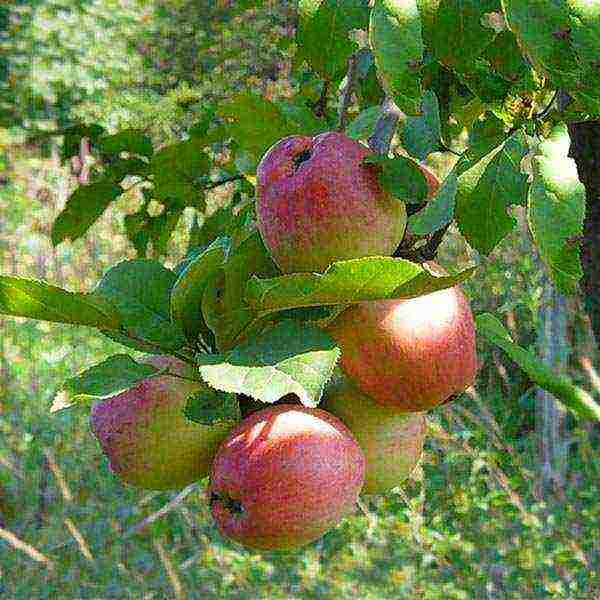
Sun.
You can find out more about the Sun apple tree here.
Arbat
This variety not only dwarf, but also columnar, it is distinguished by a quick entry into fruiting (the first crop can be harvested for 2 - 3 years after placing in the garden), disease and pest resistance and excellent frost resistance, which makes it possible to cultivate it in the northern regions.
Fruits are medium-sized, elliptical, covered with a strong shiny skin of a rich red-pink hue. Inside, the fruit is fragrant, creamy, juicy and sweet, with a slight sourness.
Once harvested, they can be stored for up to several months, but may lose taste over time.
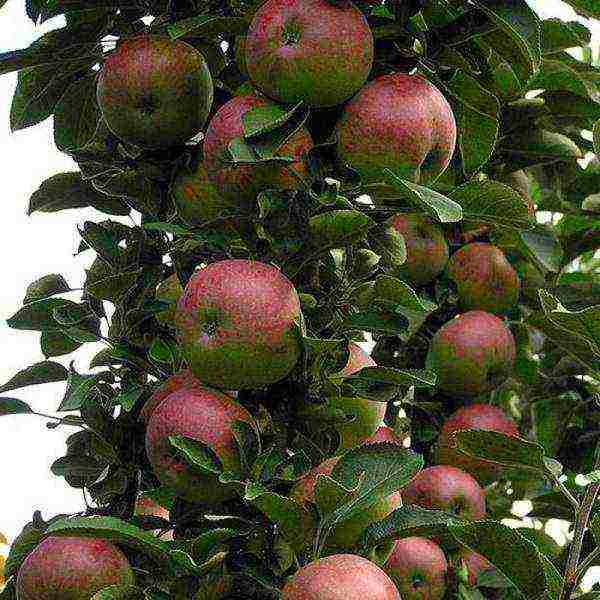
Arbat.
You can read more about the Arbat apple tree here.
For the middle lane
 In order to choose the right variety of apple trees for cultivation in a certain region, you need to understand what requirements they must meet.
In order to choose the right variety of apple trees for cultivation in a certain region, you need to understand what requirements they must meet.
So, the middle strip of our country is characterized by frequent return frosts in spring, possible frosts in early autumn, as well as slushy warm winters, in which the root system of a number of horticultural crops may be soaked.
Such weather conditions can be abruptly replaced by frost, which is the main problem.
Low-growing varieties for the middle lane:
- Melba;
- Candy;
- Zhigulevskoe;
- Autumn striped;
- Grushovka Moscow;
- Bogatyr;
- Arbat;
- Moscow necklace;
- Bratchud;
- Legend.
Useful photos and videos

Grushovka Moscow.
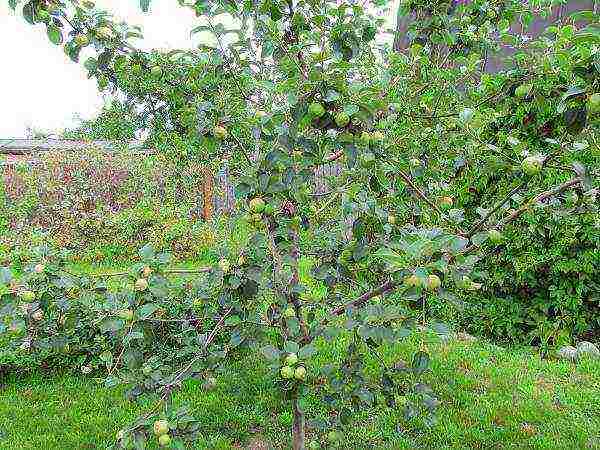
Bogatyr.
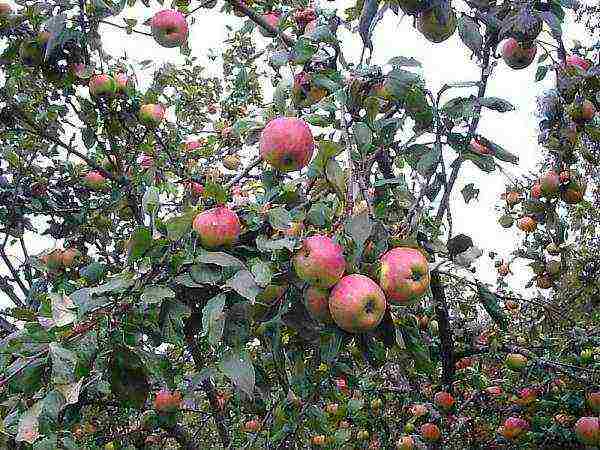
Autumn striped.
Watch a video describing the varieties listed above:
Watch a video about dwarf apple trees:
Watch a video about the varieties Sokolovskoe and Kovrovoye:
Watch a video about Yablona Arbat:
Conclusion
Understanding what is necessary for the successful cultivation of dwarf apple trees, you can easily choose the perfect variety, draw up an agrotechnical plan for him, choose the best place in the garden.
Among the great many works of breeders to date even the most picky gardener will find the apple tree of his dreams!
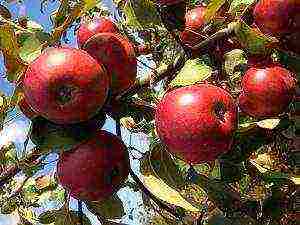 The most common type of fruit tree is the apple tree; tree varieties grow in all corners of the globe. The fruits are known for their beneficial properties to everyone, from early childhood to old age, doctors recommend eating two medium fruits a day.
The most common type of fruit tree is the apple tree; tree varieties grow in all corners of the globe. The fruits are known for their beneficial properties to everyone, from early childhood to old age, doctors recommend eating two medium fruits a day.
With such prevention, a person will never have anemia, the gastrointestinal tract will never fail, the intestines will function perfectly, clearing away unnecessary deposits in a timely manner.
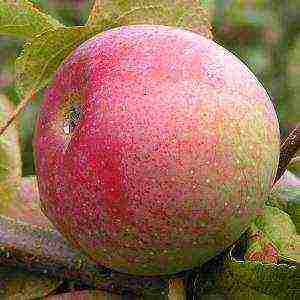 In addition, apples have a positive effect on the functioning of the heart, kidneys, pancreas and thyroid gland.
In addition, apples have a positive effect on the functioning of the heart, kidneys, pancreas and thyroid gland.
But growing an apple tree is half the battle, most gardeners plant a seedling with the hope of a big harvest.
For abundant and regular fruiting, take into account not only the characteristics of the variety, but also the climatic conditions that are most acceptable to him.
Consider in the article below the Belarusian varieties of apple trees, their detailed descriptions and photos.
General characteristics
The Belarusian land has always been famous for its fertility, various horticultural crops are grown, and the fruiting is always excellent. Breeders of local research institutes have bred apple varieties specifically for their lands, with different ripening periods, with a wide range of tastes.
The main criteria for the grades are:
- good frost resistance;
- increased immunity to various fungal diseases, scab in particular;
- large fruit size;
- good taste of the resulting crop.
The varieties will also differ in the size of an adult tree, in order to accelerate the onset of fruiting, apple trees are grown on dwarf and columnar rootstocks.
Interesting! The crown of such a tree will be small, this will greatly simplify harvesting.
There are many varieties suitable for growing in Belarus, but there are a couple of dozen main ones that are most common on the territory of the country.
The best varieties of apple trees in Belarus
Summer
 On the territory of Belarus, apple trees with different ripening periods are grown; summer varieties of apple trees are very popular.
On the territory of Belarus, apple trees with different ripening periods are grown; summer varieties of apple trees are very popular.
Below we will consider the most studied and common varieties for Belarus.
Kovalenkovskoe
Kovalenkovskoe, bred by leading specialists of the "Institute of Fruit Growing" of the National Academy of Sciences of Belarus. The fruits of the stem have high consumer and commodity ratings.... Apples, even unripe, have a sweet taste, without any sourness, large, up to 250 g each.
The ripening period is late summer, the color of the fruits is mainly green with a pronounced rich blush over the entire surface. Consumer maturity is reached 2 weeks after removal. The stem tolerates frost and drought well.
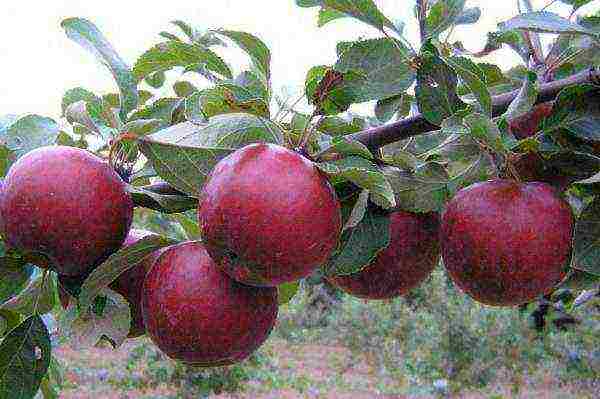
Kovalenkovskoe.
You can read more about the Kovalenkovskoe apple tree here.
Robin
Dessert fruit taste and attractive appearance serve as a calling card for the Robin. The variety has folk roots with early maturing periods. The stem perfectly tolerates the winter cold, but does not like rainy summer. Under such weather conditions, it is often exposed to scab, fruit rot.
Fruits of yellow color with a bright blush can reach 160 g. Removable and consumer maturity coincide, starting from the second half of August and until the beginning of September, apples are harvested and processed, or left for storage until October.
The variety is familiar to gardeners not only in Belarus. In the Baltic States and Finland, the apple tree feels great, pleases with good harvests.
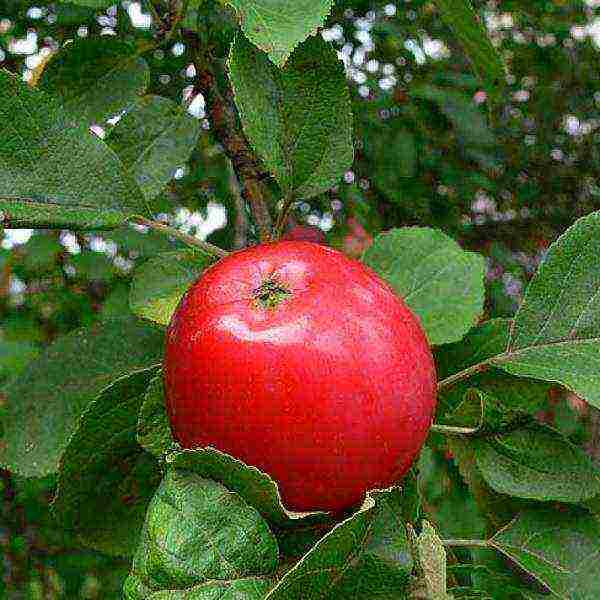
Robin.
For more information about the Malinovka apple variety, see here.
Radiant
By crossing the Kovalenkovskoe and Bananovoe varieties, the breeders bred the Luchezarnoye apple, which in 1998 was transferred for testing. The fruits of the stem have an excellent sweet and sour taste, but not long shelf life.
The tree itself is resistant to frost and scab, bears fruit annually and abundantly. Removable maturity falls in September, preferably before November.
Advice! Although the tree does not grow tall, it is best to grow on a dwarf rootstock.
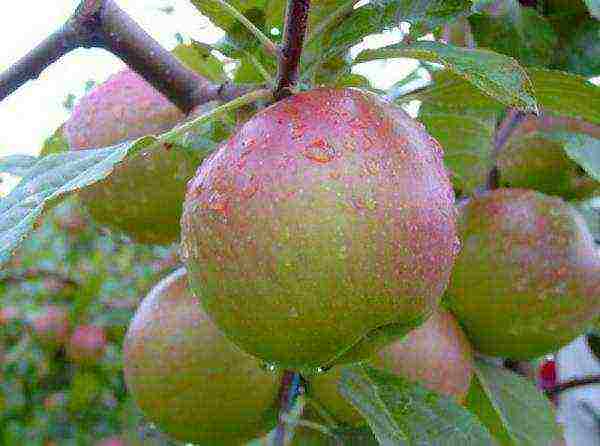
Radiant.
You can find out more information about the Radiant variety here.
Belarusian sweet
Belorussian sweet, bred by local breeders, also belongs to the late summer varieties.
Distinctive features of the trunk are high resistance to scab and other diseases, frost resistance.
Fruits are large, with juicy pulp, have a pronounced blush throughout the skin. Starting from the second year, the apple tree will bear fruit regularly and abundantly, the crop can be consumed immediately after being removed from the crown.
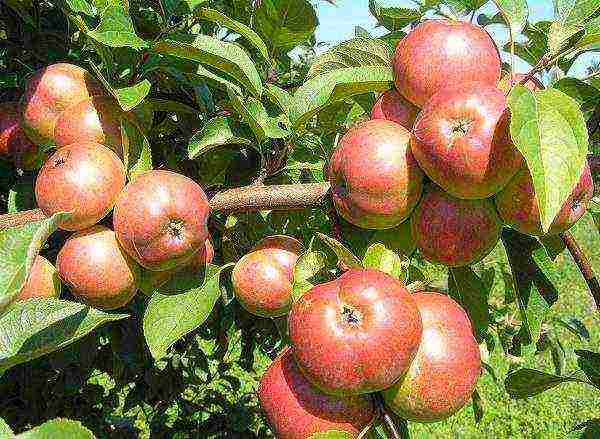
Belarusian sweet.
You will learn more about the Belarusian sweet apple variety from this article.
Minsk
Since 1967, the Minskoye apple-tree bred by A.E.Syubarov has been included in the State Register of Belarus. The stem has an average crown height, bears fruit annually and abundantly. The fruits are green with yellow color, large, juicy. Sweet and sour taste was rated at 4 points on the generally accepted world scale.
Apples harvested as much as possible in September lie until early December.

Minsk.
Elena
Early varieties of apple trees are also supplemented by Elena's apple, which it has excellent taste. The sweetness of the tender pulp, combined with the sourness, yielded 4.8 points in the assessment. The fruit is unusually fragrant, ripens in August, but does not lie.
Myself low stem, with a rounded crown. Characterized resistant to scab and frost... Bears fruit regularly and abundantly.
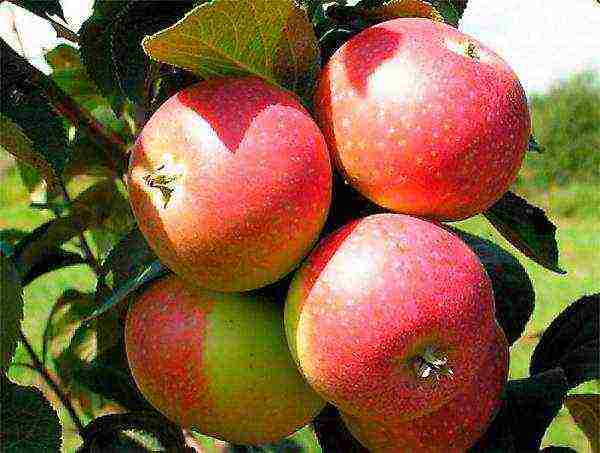
Elena.
For more information about the Elena apple variety, see here.
Champion
In mid-September, the Champion is harvested. The variety was bred in the Czech Republic, has a high resistance to fungal diseases, perfectly tolerates winter frosts up to 40 degrees. A distinctive feature is excellent transportability and great taste.
Fruits of a greenish color with a blurred soft blush of a large size are known all over Europe.
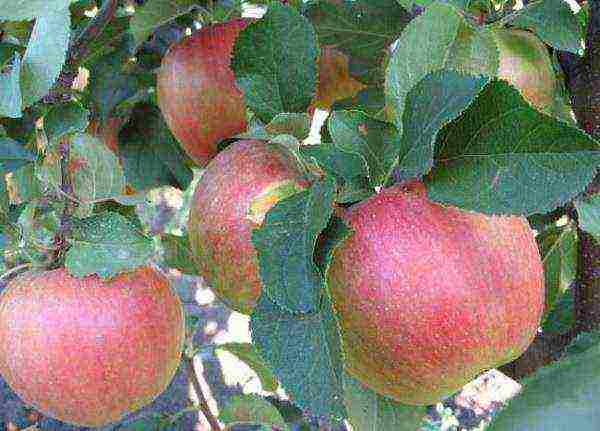
Champion.
You can find out more information about the Champion variety here.
Spartan
At the end of the first month of autumn, Spartan apples are poured together. The variety was bred back in 1926 and is still quite popular. The fruits are of medium size, colored yellow with an abundant blush. Sweet taste without sourness at all.
A feature is high resistance to all fungal diseases, abundant fruiting, unpretentious care.
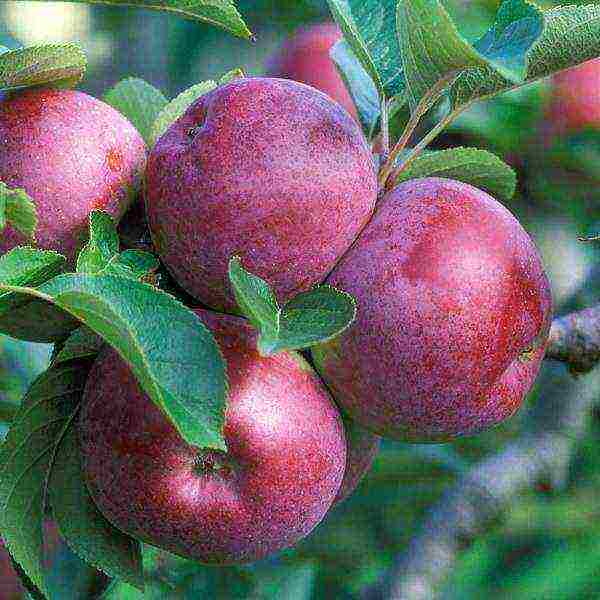
Spartan.
You will learn more about the Spartan apple variety in this article.
Geneva
The American Geneva, bred in the 60s of the last century, also took root well on the Belarusian lands. The variety has excellent fruiting performance, apples are large, sweet and sour, attractive appearance.
The stem grows medium in size, up to 5 m in height. Resistance to frost and disease is not high, at minus 20 the buds of the apple tree are severely damaged. With the help of fungicides, the tree can be protected from scab and other fungi.
Ripened in july apples are practically not stored, they are consumed fresh and processed.
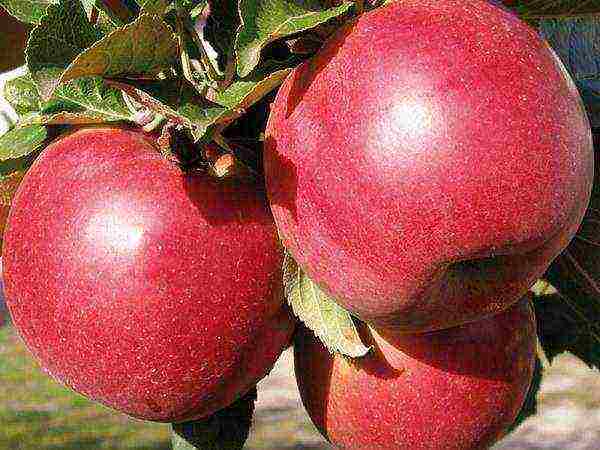
Geneva.
Winter
For those who like to savor an apple during the cold season, winter varieties are more suitable.
Honey Crisp
Honey Crisp or honey crunch will appeal to many. The stem was bred by gardeners in the United States, but it is widespread throughout Europe.
The fruits of the tree have a rounded, slightly elongated appearance. The skin is yellow, with a blush. The taste is sweet, in the northern regions of cultivation, a slight sourness is allowed. The pulp is very crunchy when biting off, from this feature the name comes from.
The harvest is harvested in late September, early October, but the apples should reach. Consumer maturity does not come earlier than November, but they can lie until May.
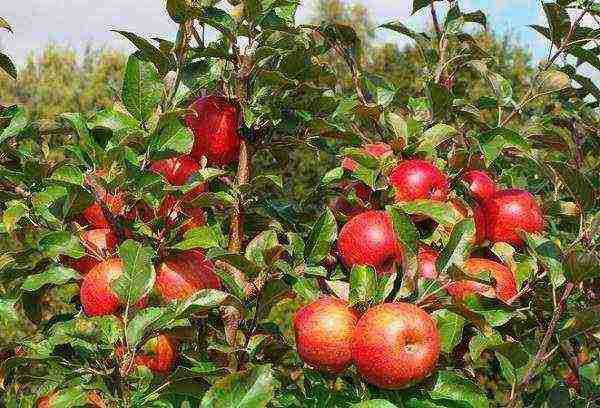
Honey Crisp.
For more information about the Honey Crisp apple variety, see here.
Navavita
Apple varieties of Belarusian selection offer us the Navavit apple tree. Her apple lies perfectly until Marchoften used for juice processing. Fruiting begins in the third year after planting, abundant. The apples are flat, greenish with minimal blush, the taste is sweet and sour.
The tree itself has a spreading crown with many branches.

Navavita.
Belana
Belana belongs to the winter-hardy varieties with a long shelf life. The fruits have a wonderful sweet taste, which is the best complement to the sourness. Shelf life after removal is long, until April.
The stem itself has a stable immunity to scab and other fungi, but preventive treatment in the spring will not hurt. It is also not afraid of frost, it tolerates them perfectly.
The crown is branched, spreading out, and requires annual pruning even in adulthood.

Belana.
Antaeus
Antey is distinguished by a high yield among late winter varieties. His fruits lie perfectly until Maywhile maintaining great taste. Apples have a beautiful red and burgundy color that attracts the attention of buyers.
The stem bears fruit annually and abundantlytherefore it is often used for cultivation on farmland.
Important! Agricultural technology and unpretentiousness contribute to the growing popularity of the winter-hardy variety among horticultural farms.
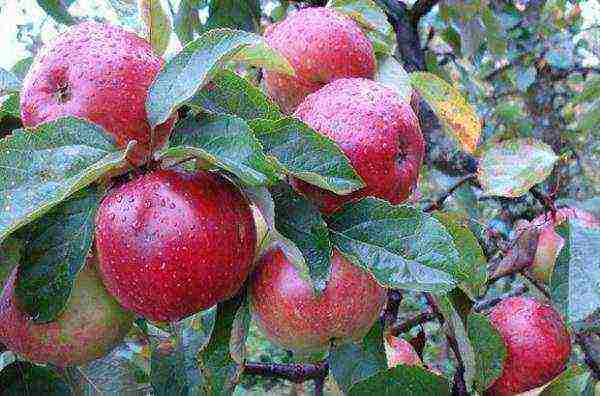
Antaeus.
You can read more about the Antey apple tree here.
Auxis
Lithuanian bole Auxis successfully grows and bears fruit in the Belarusian lands. Its fruits are of medium size, are distinguished by high keeping rates, subject to the necessary conditions. The pulp is juicy, fragrant, with a spicy aftertaste. Sweetness perfectly complements the sourness, their tandem perfectly refreshes. The color of apples is yellowish-green with a blush over the entire surface.
The tree grows to medium size, has a compact crown. Frosts down to minus 20 are not terrible for him, stronger ones are capable of causing harm.Scab and other fungi can periodically attack the bole, it should be protected by applying fungicides.

Auxis.
For more information about the Auxis apple variety, see here.
Lobo
The Canadian variety Lobo was recently discovered by Belarusian gardeners. The stem differs sufficient frost resistance, high palatability of fruits, long-term storage of the crop.
The disadvantages include periodic infection with fungal diseases, but, if the climate is not humid, the tree practically does not get sick.
Large fruits have a good presentation.

Lobo.
Find out more about the Lobo variety here.
Zaslavskoe
The apple variety Zaslavskoye has been included in the register since 2002, but has rapidly spread among gardeners. Late winter bole is distinguished by high immunity to scab, frost resistance.
Fruits are sweet with sourness, aromatic, perfectly stored until May.
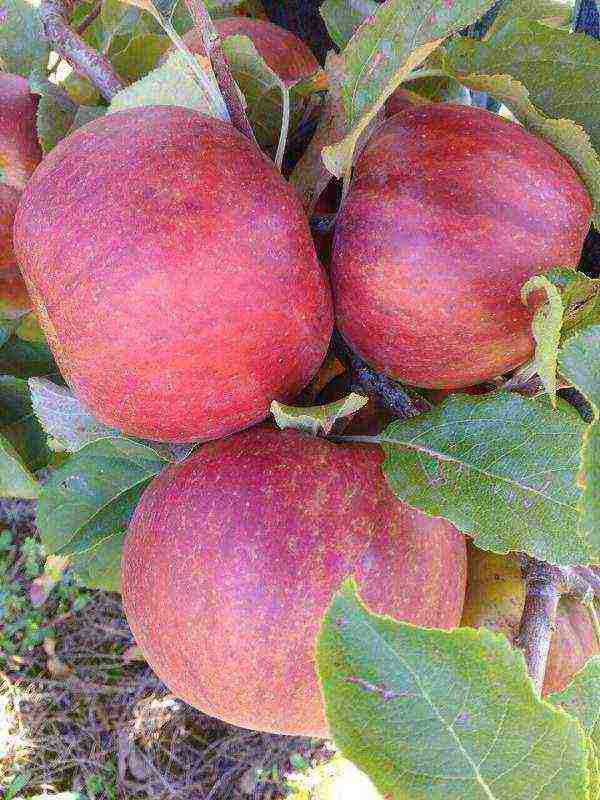
Zaslavskoe.
You will learn more about the Zaslavskoe apple variety from this article.
Kochtel
Koshtela is the most widespread variety in the Gomel and Brest regions. It is characterized by an excellent taste of apples, which will last until March.
Resistance to frost and scab allows growing boles in other parts of the country and abroad.
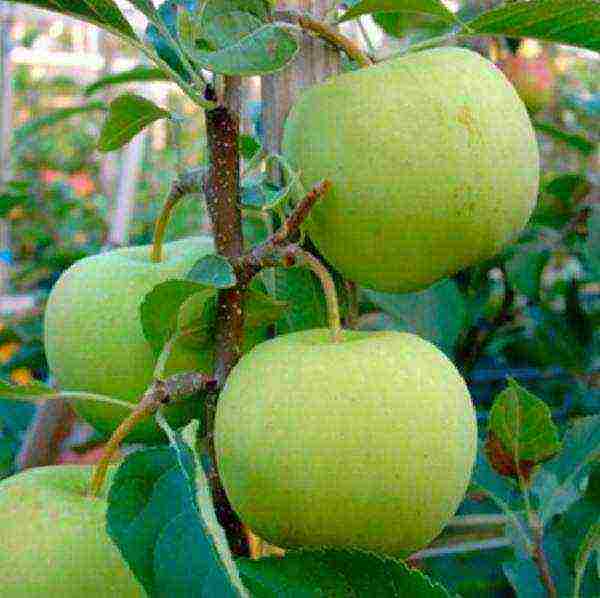
Kochtel.
Idared
Idared is grown not only in private gardens, but also on an industrial scale. Excellent keeping quality and transportability of the crop contributes to this.
The stem is classified as medium-sized, regularly fruiting. The fruits are large, with excellent taste, they are consumed fresh and processed.
The winter varieties of Syabryna and Pospeh also have similar characteristics.
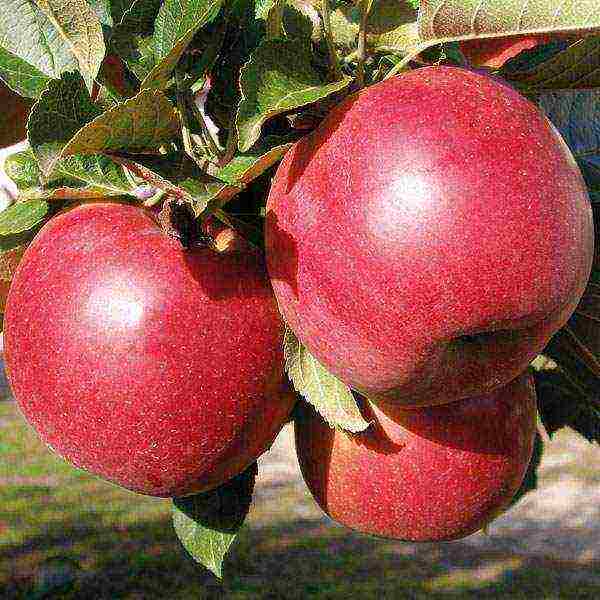
Idared.
For more information about the apple variety Idared, see here.
Dwarf, undersized and columnar stems
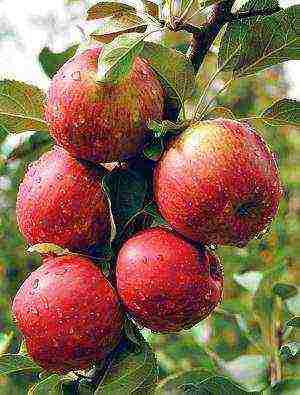 In order to save space on the site and plant more different varieties, gardeners increasingly prefer compact apple trees.
In order to save space on the site and plant more different varieties, gardeners increasingly prefer compact apple trees.
On a dwarf rootstock, you can grow:
- Idared;
- Geneva;
- Champion.
Columnar is best done:
- Robin;
- Kovalenkovskoe;
- Radiant.
They differ in stunting:
- Lobo;
- Belarusian sweet;
- Honey Crisp.
Varieties rating
In order for the garden you planted to develop and regularly bear fruit you need to carefully consider the choice of varieties. Pay special attention to:
- for pollinating varieties that will grow in the neighborhood. To do this, select similar stems with the same or different ripening periods;
Advice! "Raika" will be a universal pollinator for any apple tree.
- the soil in which the seedlings will be planted will also be important. Each variety has its own characteristics and preferences for soils, it should be taken into account without fail;
- fertilization and feeding of plants should be carried out regularly;
- remember to trim and trim the crown.
These are universal tips for all boles, but for the lands of Belarus, it is worth choosing seedlings for planting:
- with good indicators of frost resistance, because often the thermometer shows low temperatures, which can simply destroy the laid flower beds;
- have immunity to scab and other fungal diseases that can negate your efforts to care;
- regular yield is desirable, then the gardener will be with fruits annually;
- choose varieties on a dwarf or columnar rootstock, this will significantly speed up the time of fruiting;
- Drought resistance is also important, because it is not always possible to water trees in hot weather.

Seedlings of apple trees with a closed root system.
These characteristics are inherent in many varieties of both domestic and foreign selection, which perfectly take root and bear fruit.
One has only to study in more detail the features of a particular variety and take care of the seedling with full responsibility.
By sweetness
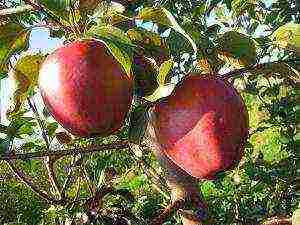 You can also choose seedlings according to your individual taste preferences. Lovers of sweet apples will like:
You can also choose seedlings according to your individual taste preferences. Lovers of sweet apples will like:
- Kovalenkovskoe;
- Belarusian sweet;
- Spartan;
- Honey Crisp.
Scab resistance
Abundant fruiting also depends on the immunity of the tree, the higher it is in relation to scab and other fungi, the greater the yields. These diseases are not terrible:
- Radiant;
- Belarusian sweet;
- Minsky;
- Elena;
- Champion;
- Spartan;
- Belane;
- Zaslavsky;
- Kostele.
Apple scab.
By maturity
Autumn
 The period of fruit ripening will also be important, at the beginning of autumn you can use:
The period of fruit ripening will also be important, at the beginning of autumn you can use:
- Melba;
- Elena;
- Radiant;
- Kovalenkovskoe;
- Robin;
- Geneva;
- Belarusian sweet.
Winter
During the cold season, apples will help remind you of summer:
- Honey Crisp;
- Navavita;
- Belana;
- Antaeus;
- Auxis;
- Lobo;
- Zaslavskoe.
Useful videos
Watch a video about winter varieties of apple trees:
Watch a video about autumn varieties of apple trees:
Watch a video describing the summer varieties of apple trees:
Watch a video on how to properly care for seedlings:
Conclusion
The apple orchard is pleasing to the eye both at the time of flowering and during the period of fruit ripening. Proper care will lead to high yields, which, depending on the variety, can be stored for quite a long time.
Apple trees occupy 95% of the area of all fruit plantations in Belarus, not only the best varieties from all over the world are grown, medium-sized, tall, dwarf, columnar apple trees, but, most importantly, varieties of Belarusian selection.
Features of Belarusian breeding
In Belarus, even in Soviet times, a large selection work was carried out, which does not stop to this day, Belarusian varieties are known to gardeners from different countries. Of the new ones, I would like to name such early or summer varieties: Kovalenkovskoe, Orlovim, Dream. They ripen in July and can only be stored for one month. Well known to professionals are such autumn varieties, zoned for the Vitebsk region: Luchezarnoe, Orlik, Auxis.
Autumn apples are good because they ripen at the beginning of autumn, they can be eaten for up to three months without losing the quality of the fruit. But winter varieties are considered the real elite of apple culture; they give a harvest in early autumn, store it for about five months. The latest technical ripeness comes in October, and they are recommended to eat in a couple of months, when the sweetness and aroma intensify, they can be stored until the next harvest.
Among them, columnar apple trees occupy an important place, and from the local ones, Alesya, Freedom, Pamyat Kovalenko, Verbnoe, Pospekh, Zaslavskoe, Antey, Belorusskoe Raspberry received excellent reviews. The varieties of their apple trees are well known in Belarus, for many of them the Golden Delicious apple tree served as a selection material. Before deciding which apple trees to plant in your garden, you should look at the reviews, read the description and the main characteristics of the varieties, including columnar apple trees.
Belarusian sweet
The tree is medium-sized, the crown has a rounded-conical shape. Fruiting begins 2-3 years after planting in a permanent place of growth, the harvest is given every year. The tree perfectly tolerates cold winters, does not get sick with scab and other diseases traditional for this fruit crop.
Round fruits are covered with a dense, smooth skin, their weight varies between 135 and 200 g, the main color is green, almost all of the fruit is covered with a bright blush. They look very appetizing, delight with a weak aroma, pulp, white and tender, has a pleasant taste due to the large amount of sugars and ascorbic acid. After ripening, the fruits remain on the branches, but if they are harvested late, then they will lie less, they are consumed immediately after harvesting.
Verbnoe
The tree is characterized as medium-sized, it is valued for its indifference to frost and scab, for rich harvests. Its crown has the shape of an inverted pyramid, the branches are quite compact. The first crop can be removed within a couple of years after planting on the site.
Apples grow unevenly - from 150 to 300 g, their dense green skin is covered with a brown-red blush. The fruit is flat-round, greenish on the inside, and so juicy that it bites with a crunch.Fruits, sweet and sour with a weak aroma, lie until May, they are perfectly transported.
Darunak
The tree grows medium-sized, like most apple trees, its crown is rounded, branches drooping. The Darunak variety is appreciated for a good harvest, early maturity, the ability not to suffer from scab, to survive frosty winters without losses. Its fruits are round, there are ribs, but they are rather weakly expressed, the apples are very large - their weight varies from 180 to 350 g. Apples with a strong green skin are almost completely covered with a bluish-red blush by the time of harvest. Inside the apples are tender, greenish, aromatic, with a sour-sweet taste.
The fruits are removed after September 15, it is advisable to consume them not earlier than November, when they become sweeter and more aromatic, they are perfectly preserved until the spring of next year.
Elena
Elena is a summer variety, so apples ripen much earlier than all those described. The apple tree does not get sick with scab, tolerates winters well, gives a rich harvest. The tree is also medium-sized, the crown is oval, somewhat raised.
The apples are flat-round in shape, green in color, covered with a bright red-pink blush, their average weight is kept at 120 g. They belong to dessert, have a high tasting rating. The pulp is very tender, unusually juicy, sour-sweet. These delicious aromatic apples are stored, unfortunately, no more than a month.
Imant
Medium-sized apple trees of this variety are not afraid of severe frosts, cold winds and scab. They have a compact, rounded crown and excellent characteristics in terms of yield and early maturity. Apples are slightly ribbed conical in shape, when ripe, they are completely covered with a purple-red blush. The dense, creamy flesh is juicy to crunchy, sweet and sour. Harvested in October, and they begin to use it not earlier than December, by this time the sweetness and aroma will increase, it will be stored until next summer.
Armor
The tree does not grow very tall, unlike most late winter varieties. Its crown gradually acquires a rounded pyramidal shape, drooping branches, growing, lean towards the ground. The Pospeh variety is distinguished by indifference to frost and scab, high productivity, and early maturity.
Round fruits grow from 140 to 240 g, their main color is green, but almost the entire apple is gradually covered with a blurry-striped red blush. The skin of the fruit is dense, elastic, the flesh is greenish, fine-grained, juicy, sweet and sour. Technical ripeness begins by mid-October, but December is considered the time of consumer maturity, after lying down for a couple of months, apples become sweeter and more aromatic. They are perfectly transported, stored until April - May next year.
Syabryna
The Syabryn variety belongs to the winter. The tree is medium-tall, frost-resistant, does not get sick with scab, it is not afraid of unfavorable factors indifferently to spring frosts. On a clonal rootstock, fruiting begins as early as 3 years after planting, it is stable, regular, no periodicity of the harvest under normal conditions is observed. The crown has a round shape, straight branches are directed upwards, are compactly located, apples do not crumble when ripe.
The fruits are almost one-dimensional with an average weight of 130 g, the pale yellow color of the apple is gradually covered with a raspberry blush almost on the entire surface. The pulp is greenish, fine-grained and juicy with a sour-sweet taste, but rough, the skin is quite dense, which helps to preserve the fruits until the end of winter without losing quality. The variety is prone to a large harvest, it is advised to adjust the number of ovaries manually so that the fruits do not turn out to be small.
Video "Review of winter varieties of apple trees"
In this video, you will learn about the varieties of winter apple varieties.
When choosing a suitable fruit tree variety for growing, it is important to pay attention to the local climate conditions. In addition, the history of the origin of the tree variety, the place of origin is taken into account.These parameters establish the biological potential of a tree in accordance with its economic value: frost resistance, fertility and quality of fruits, resistance to diseases, especially fungal ones. A similar potential is possible in areas favorable for growth. Which apple varieties are ideal for growing in Belarus?
Breeding achievements
The Institute of Fruit Growing of Belarus of the National Academy of Sciences has developed special varieties of apple trees that have genetic resistance to the dangerous fungal disease - scab. Such varieties of the famous Belarusian selection are excellent for growing in many Russian regions that have a similar climate. Apple varieties of the selection of Belarus are planted in the Central regions of the Russian Federation, the Moscow region.
Many apple trees of the selection of Belarus are grown on a clonal rootstock. Such varieties bear fruit from the third year of life every year. As for the yield, it is much higher than on the seed stock.
These varieties have excellent frost resistance:
- Vesyalina;
- Antaeus;
- Zaslavskoe;
- Belarusian raspberry.
Susceptibility to spring frosts is noted in such apple trees:
- Topaz;
- Sava;
- Imant;
- Anniversary;
- Darunak;
- Elena;
- Liberty;
- Cliff;
- Raya;
- Nadzeyny;
- Persistent;
- Chulanovka;
- Folding and others.
The most popular summer varieties are Elena, Luchezarnoe, Papirovka and Kovalenkovskoe.
The best varieties
Darunak
There is excellent immunity to fungal scab, good winter hardiness, early maturity and high yield. Included in the state register in 2011. As for the crown of the tree, its shape is round, hanging branches prevail. Emphasis should be placed on large fruits, the weight of which is about 350 grams. The shape of the fruit is round, with a slight ribbing. The peel has a waxy coating, slightly oily. The color of the Darunak apple tree is green, but there is also a purple blush in the form of stripes covering the entire surface. The pulp is characterized by a sweet-sour aftertaste, weak aroma. According to the results of tasting, the variety is rated at 4.5 points. The advantage is long-term storage until April.
Belarusian sweet
As for this variety, it is characterized by frost resistance, excellent early maturity and resistance to scab. The average vigor of growth is noted, the shape of the crown is round, and the shape of the fruit is round-asymmetric. The weight of one apple ranges from 170 grams. The peel is green in color and an attractive red blush, which is impressive in size. Apples are stored from October to March. The variety received a tasting mark of 4.1 points. The fruits have a juicy, tender, unusually sweet and aromatic pulp.
Imant
The variety is characterized by remarkable resistance to an insidious fungal disease - scab, copes well with severe frosts and winds, is distinguished by early maturity and stable fruiting. Imant was entered in the state register in 2005. The apple tree is medium-sized, equipped with a compact and rounded crown. The shape of the fruit is blunt-conical, with ribbing. The color of the fruit is intense red, with a slight purple hue. The fruits are available from December to June. Description of the pulp: crispy, very juicy, creamy, dense, sour taste. According to the tasting score, the apple tree received 4.2 points.
Syabryna
Winter variety with excellent yield and scab resistance. Differs in average growth, beautiful round crown, stable fruiting. If the stock is clonal, then the harvest is harvested already in the third or fourth year of the apple tree's life. The approximate weight of one fruit is 130 grams. The color of the fruit is pale yellow, there is a crimson blush over the entire surface. Tasting score - 4.5 points. The fruits are eaten from October to February. The pulp is tender, juicy, sweet.
Armor
Sufficiently frost-resistant, high-yielding species. It has a slow growth rate, therefore it remains low. The branches hang down, the shape of the tree crown is rounded.As for the weight of the fruits, the average is 240 grams, the shape is round. The skin is oily, there is a waxy bloom. The apples are green, but there is also a red blush. The pulp is aromatic, sweet and sour and juicy. Tasting mark - 4.1 points. The term of consumption is late. Stored until April.
Elena
If we take into account the summer varieties of apple varieties, then Elena is the ideal representative. The variety is new, early ripening is inherent in it, namely, a week earlier than Papirovka. Excellent resistance to frost, good yield - 25 tons per hectare. It is remarkably protected from scab fungus, has a dessert taste. The apple tree is medium-sized, the crown shape is slightly raised and oval. As for fruiting, it is stable and generous. The fruit weighs 120 grams, the shape is flat-round. The main color of the fruit is green, the cover color is red-pink. The tasting score is 4.8 points, which is considered an excellent indicator. The pulp of these apples is unusually juicy, fragrant and tender, fine-grained. The consumption period is August.
Verbnoe
Refers to the late winter ripening period. There is a good yield - 30 tons per hectare, as well as frost resistance. The average growth rate of the tree prevails. The crown is characterized by an average density and a rounded shape. The yield is regular. The main advantage is recognized rather early fruiting, since the first crop is harvested two years after planting the seedling in the ground. There is a chic polygenic resistance to a fungal disease - scab. It is important to note that the size of the apples is quite impressive, the weight is equal to 250 grams. The shape of the fruit is flat-round.
Color - pale green, there is a blush of a red-brick shade. Description of the pulp: juicy and fine-grained. Score - 4 points. The aroma is not very pronounced. As for the chemical composition of Verbnoe apples, it is important to point out the following components: sugar - 9.3%, ascorbic acid - about 12 mg per 100 grams, dry matter - 10.7%, and titratable acidity - 0.8%.
The marked apple varieties are very popular. They are resistant to frost and fungal scab disease. Each of them bears fruit regularly, has large and medium-sized fruits. The main advantage is that fruits are stored for a long time, do not rot. Trees need proper planting, regular and competent care, feeding and pruning. All agrotechnical activities are carried out according to the standard scenario.
The climatic conditions of Belarus are favorable for growing apples. Every year the country gathers rich harvests of these tasty and healthy fruits. Along with the old ones, new and promising apple varieties bred by breeders are successfully cultivated.
The best apple varieties for Belarus with a description, characteristics
Natural conditions make it possible to grow apple trees in Belarus, zoned for the central regions of Russia. However, in recent years, Belarusian breeders have developed many new varieties that are resistant to scab and tolerate frosts, recurrent frosts and prolonged low temperatures during the flowering period. Grafted on medium-sized and dwarf rootstocks, the varieties bear fruit 2–4 years after planting. On the tasting scale, their taste is rated above 4 points. In the southwestern regions of Belarus, preference is given to apple varieties with large sweet fruits.
Summer apple varieties for Belarus
These varieties ripen in July-August. Apples cannot be stored, they must be eaten or processed immediately.
Table: summer varieties
Photo gallery: summer varieties
Early apple varieties for Belarus
Autumn and early winter apples can be picked in late August and early September. They acquire consumer maturity after one to two weeks. Fruits can be stored for several months, up to January.
Table: autumn and early winter varieties
Photo gallery: autumn and early winter varieties
Late varieties of apple trees for Belarus with a description, characteristics
Winter and late winter varieties are distinguished by increased keeping quality. They are filmed in late September and early October. These apples can last until summer, and acquire a full-fledged taste a few months after they were removed from the tree. Late-flowering trees are able to withstand recurrent frosts without consequences. The fruits are distinguished by a firm skin and dense pulp. The long ripening period of apples increases their vitamin content.
Table: winter and late winter varieties
Photo gallery: winter and late winter varieties
Features of growing apple trees in Belarus
The moderate continental climate of Belarus is favorable for growing apples. In winter, against the background of moderate cold weather, prolonged thaws can be observed. It is warm in summer, it rains a lot.
In the northeast, in the Minsk region, spring comes at the end of March. In the south-west (Grodno region), spring begins in the first ten days of March. Signs of autumn are earlier observed in the northeast, in the second half of September. In the southwestern regions, summer lasts until early October.
Soils in most of Belarus are soddy, but there are also sandy and loamy soils. Groundwater in some places comes close to the surface. The increased acidity of the soil requires the use of special agrotechnical measures.
Planting an apple tree in Belarus
You can plant an apple tree in spring - in April, and in autumn - in October. Adherents of autumn planting believe that the seedlings will have time to take root before winter and will actively start growing in the spring. Others are confident that planting in spring will help the plant grow better.
In spring, it can be planted when the ground has already thawed (from late March to late April). In the Bryansk and Gomel regions, planting begins a little earlier than in the north of Belarus.
When choosing a seedling, pay attention to its method of grafting. An apple tree on a dwarf (clone) rootstock begins to bear fruit earlier, but a tree on a seed rootstock lives longer.
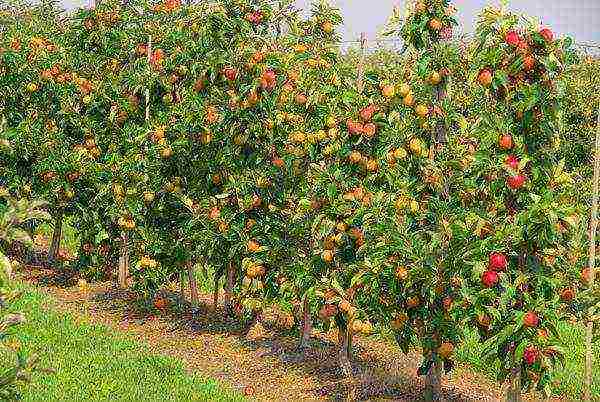
Despite their size, apple trees on a dwarf rootstock give a rich harvest.
High humidity and cool weather during the growing season, characteristic of the climatic conditions of Belarus, contribute to the development of scab. When choosing seedlings, preference should be given to varieties that are resistant to this disease.
It is advisable to purchase seedlings with an open root system immediately before planting. If it is not possible to immediately plant a tree in its intended place, take measures to preserve the vitality of its roots.
- Moisten the roots, wrap them with a wet rag, wrap them in a plastic bag and put them in a cool, dark place.
- Place the roots in water for several hours before planting.
If you bought a seedling in the fall, and you plan to plant it in the spring, dig it into a trench 50 cm deep in an inclined position.
Recommendations for choosing a seedling taking into account the groundwater level (GWL):
- GWL> 3 m - a seedling is suitable for any rootstock.
- GWL <1.5 m - give preference to dwarf rootstock.
- With a groundwater level of 1.5 m to 2.5 m, a seedling can be planted on a semi-dwarf rootstock.
In Belarus, there are practically no heavy wetlands, so there is no need to prepare a pit for planting in the fall. The rules for preparing holes for planting depend on the size of the tree:
- for dwarfs - 90x90x40 cm, distance 1.5x3 m;
- for semi-dwarfs - 100x100x50 cm, distance 3x5 m;
- for the tall - 120x120x80 cm, distance 5x5 m.
If planting in sandy soil, place a 15 cm layer of clay on the bottom of the pit. The root collar should be at soil level when planting. Do not add fresh manure to the planting pits: ammonia and hydrogen sulfide released by it during decomposition will damage the roots.
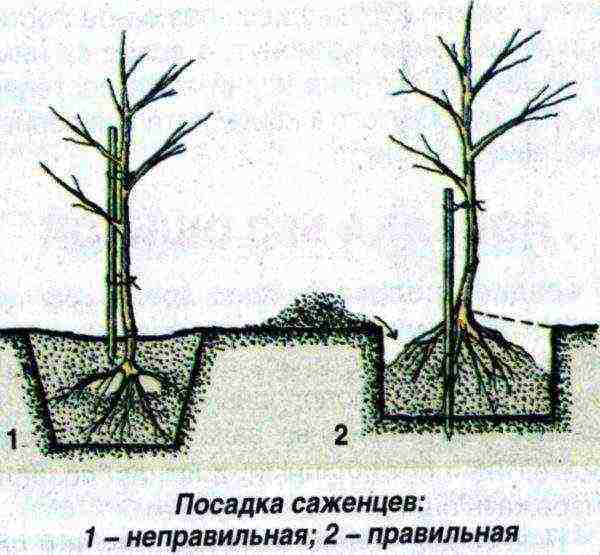
Scheme of planting an apple tree seedling in a pit
With a high level of groundwater standing, the seedling is recommended to be planted on a hill. At high humidity, trees are planted on ridges more than 1 meter wide and up to 50 cm high.

With a high level of groundwater, an apple tree is planted on a hill.
How to care for an apple tree in Belarus
Apple tree care includes standard procedures:
- watering,
- feeding and fertilizing,
- protection from disease,
- pruning,
- harvesting,
- preparation for winter.
Newly planted and dwarf trees are especially in need of watering. Over the summer, this procedure must be repeated 3-4 times, based on the norm of 3 buckets for each tree. Watering is stopped during the ripening of the fruit so that the apples do not crack. In October, trees need ample moisture to prepare for winter.
Nitrogen fertilizers are applied in the spring, phosphorus and potassium fertilizers in the fall. If the soil is acidic, ash or dolomite flour is added to the trunk circle in the fall.
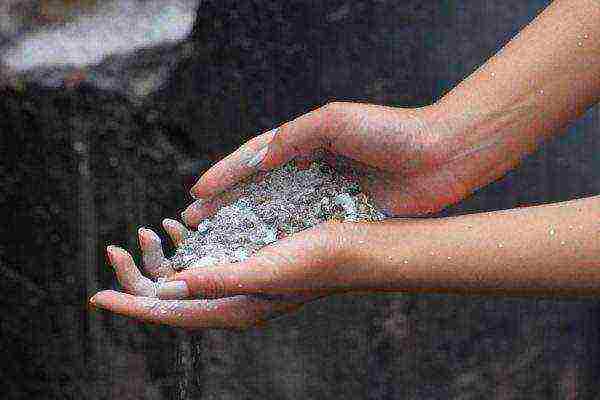
Ash does an excellent job with soil deoxidation
If the tree is frozen, foliar feeding with a solution of urea (0.5%) will help it recover. The first feeding is carried out 10 days after flowering. To fix the result, the tree is sprayed again after 1-2 weeks.
After harvesting, it is useful to spray the tree with a 2% solution of copper sulfate. This treatment will kill pest larvae and fungal spores.
We prune the tree in autumn or spring. In autumn, this procedure can be done from the beginning of leaf fall and until the temperature passes through -10 ° C, until December. In spring, you can start caring for the apple tree after March 8 and finish before its flowering.
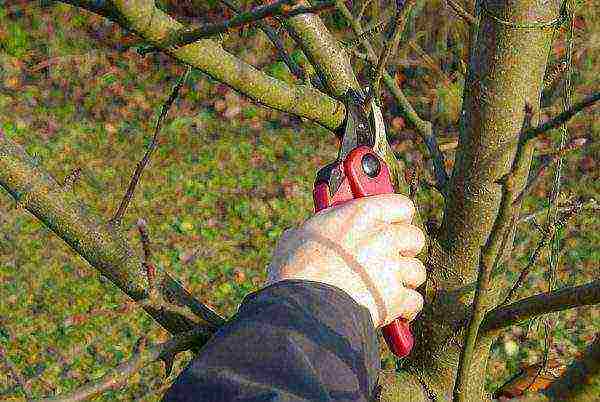
It is recommended to prune fruit trees twice a year: in autumn and spring.
Late varieties of apples keep well until spring and even until summer, if you follow the basic rules of harvesting:
- Observe collection deadlines.
- Do not rub wax deposits off apples.
- Withstand quarantine: apples in a box should stand for 2-3 weeks in a cool place, after that you must select and remove all low-quality fruits.
- For storage, you need to put apples (no more than 3 kg) in tight plastic bags, make 5-6 holes in the bag with a match / toothpick for gas exchange and tie the bag with a rope.
- Place bags in boxes and store at temperatures between -1 ° C and +1 ° C. But you can't keep apples in the same basement with potatoes!
Before wintering, it is recommended to insulate the trunk of a young tree: tie it with spruce branches or straw. It is advisable to cover the near-trunk circle with a layer of moss and spruce branches.
Video: tips for growing and caring for an apple tree
Reviews
Plant apple trees of different ripening periods on your plot - summer, autumn, winter. Then you will be provided with apples almost all year round. Modern Belarusian varieties with excellent characteristics in taste, winter hardiness and disease resistance can be successfully grown in central Russia.
Ripe juicy apples picked from your garden are much tastier than those bought at the market or in the supermarket. After growing apple trees, the gardener puts his heart and soul into this difficult business. But quite often it happens that the varieties that we loved from neighbors or friends are not suitable for planting on our site. Most often, this is due to the small area of free land. Every year breeders develop new varieties so that we can make our wishes and dreams come true. In small areas, you can plant dwarf apple trees, which are not inferior in quality to their tall counterparts.
Features of growing dwarf apple trees
The process of planting and caring for mini versions of fruit trees differs little from other species. But some nuances still exist. For example, it is unlikely that it will be possible to withdraw a dwarf variety from the usual one on your own. If we are planting an apple tree for the first time in our life, we should not suffer with vaccinations and reproduction, it is better to purchase seedlings in horticultural centers or at the poultry market.
Are apple trees different from different rootstocks
What is a dwarf rootstock? Why are varieties with the same name considered dwarf, semi-dwarf or medium-sized? Let's try to deal with these questions that arise for any novice gardener.
To get a new apple tree, a seedling must be grafted. A branch of a certain type that needs to be grafted onto a tree is a scion. The place to which the cutting is transferred is the stock. Allocate:
- clonal stock (growing in a vegetative way);
- seed (an apple tree is grown from a seed).
Thus, the same variety can be bred on a dwarf rootstock, and on any other. When grown, for example, on seed, the same varieties Melba, Golden Delicious, Kovalenkovskoye and others have the characteristics of tall or medium-sized apple trees. They, grafted onto a dwarf tree, acquire the qualities of dwarf trees.
Breeders are constantly working to create "real dwarfs" that do not require grafting.
Important! When buying seedlings, you need to ask the seller on which rootstock the variety was grown.
How to choose a seedling
The tree must be healthy, with a well-developed root system. When buying, we inspect the roots for damage. The twigs should not be dried out. Vaccination is required. If there is no vaccination, then we are dealing with a wild apple tree. But there are other points by which you can distinguish the variety from the wild:
- The grafting site is traditionally located between the stem and the root collar. It has the shape of a small protrusion.
- The developed branches in a varietal grafted plant should be at least four.
- The 0.5 meter stem also indicates that we are purchasing not a wild, but a varietal apple tree.
- A grafted dwarf seedling has many small and flexible roots, it does not have a taproot, unlike a wildflower.

Varietal apple trees can be distinguished from wild ones by the presence of grafting and the number of developed branches.
Planting and caring for trees in spring
Dwarf apple trees, like ordinary ones, are planted in open ground in autumn and spring. Planting is carried out during the period of "hibernation" of plants, when the earth has already warmed up a little, but the tree buds have not yet blossomed. Gardeners are advised to prepare holes for seedlings in the fall, so that fertilizers are absorbed into the soil and the soil is compacted. If it was not possible to prepare the place in advance, we proceed as follows:
- We dig a hole 60–70 cm deep. Its diameter should be at least 60 cm.
- We stick a wooden stake into the landing pit.
- Add fertile soil to the hole.
- We pour in 0.5 kg of ash, a bucket of humus and 0.5 kg of superphosphate. Mix with the soil.
- We cover with fertile soil. The layer thickness should be 2–3 cm so that the roots of the apple tree do not touch the fertilizer.
- We lower the seedling into the hole, straighten the roots.
- The inoculation should be above the ground at a height of 3-4 cm.
- We compact the soil after planting the apple trees.
- Pour 2-3 buckets of water under each tree.
- We mulch the soil with humus.
Caring for dwarf trees is easy:
- The root system is located in the upper layers of the soil, so we make sure that the soil does not crack, does not dry out. After watering, we loosen the ground no deeper than 5 cm.
- At the beginning of spring, we whitewash the trees with lime.
- Once every 2 weeks, we feed with complex fertilizers: azofos, ecofos or any others.
- In the spring, apple trees also need nitrogen and phosphorus fertilization. You can use wood ash, urea, nitrophosphate. We apply fertilizers according to the instructions on the package.
Video: planting a dwarf apple tree on an M-9 rootstock
Mandatory procedures in summer and autumn
Care in the hot season consists in loosening the soil and watering. It is important to ensure that the soil does not dry out or crack. As for the planting of dwarf apple trees in autumn, it is similar to the spring one. In the fall, you need to carry out the following procedures:
- Cut off old and overlapping branches from the tree.
- We loosen the soil so that the pests cannot overwinter at the roots.
- As a preventive measure, we spray the apple trees with Bordeaux liquid (1%).
- For the winter, we cover the soil around the tree with a thick layer of humus so that the apple trees do not freeze out during the snowless period.
Video: we form a dwarf crown
Top dressing of apple trees
In spring, many plants lack nitrogen and phosphorus.Dwarf apple trees are no exception. We can use mineral complex fertilizers containing the necessary substances, including potassium.
Action plan:
- Dissolve fertilizers in 10 liters of water according to the instructions on the package.
- We make small pits in the soil, as if pushing the layers of the earth with a shovel. We pour fertilizers into them.
- Then cover the trunk circle with mulch. You can use processed peat mixed with humus, sawdust, compost.
We carry out top dressing according to the plan:
- In the spring, after the soil has warmed up.
- During the flowering period. We use organic fertilizers: peat, compost, chicken droppings.
- While pouring the fruit. For one adult apple tree we take a mullein (3 kg) and warm water (30 l).
- After harvest. We need nitrophoska (150 g) and warm water (30 l).
Video: features of spring feeding
Overview of common dwarf apple varieties
The main difference is the crown diameter is no more than three meters. Quite often they are confused with columnar varieties.
When buying seedlings, it is really easy to get confused. For example, Melba, grafted onto a dwarf stock, is very similar to a columnar apple tree up to three years old. In adult columnar trees, the crown consists of one trunk on which the fruits grow. Dwarf apple trees have a branched crown.
It is quite easy to distinguish seedlings in the market or in the garden center: in a dwarf apple tree, the trunk and roots branch out. The columnar has no branching on the trunk, and the root has the shape of a rod.
The best dwarf apple varieties
The generally accepted classification is according to the period of fruit ripening. Allocate:
- Early varieties (fruits ripen in summer). This is:
- Candy;
- Early sweet;
- Melba;
- Golden Delicious.
- Mid-season varieties (ripen in early autumn):
- Sun;
- Sokolovskoe;
- Grounded.
- Late ripening (harvest is harvested before winter) include:
- Bogatyr;
- Carpet;
- Snowdrops.
Dwarf varieties are classified according to cold resistance, taste:
- sour;
- sweet;
- dessert.
Table: popular varieties for the Moscow region and Central Russia
Photo gallery: dwarf apples of universal varieties
The fruits of the Grushevka of the Moscow Region are small, yellow with red stripes and spots, the taste is sweet and sour. Apples of the Arbat variety are of a beautiful wine color "with frost", very juicy and aromatic, sweet, there is a piquant acidity. juicy, dessert (sweet) Melba apples have a wonderful lollipop smell and have a sweet and sour taste, you can eat just like that or use in cooking. neat, round, with a beautiful striped color and a real dessert taste: better than sweets Autumn striped apples (Strifel, Streifling) are valued for their dense juicy pulp and sweet spicy taste Apples of Belarusian sweet will definitely be appreciated by lovers of sweet fruits: the taste is clean, without sourness and astringency, honey notes are noted
The best varieties for Belarus
Gardeners of Belarus prefer to choose cold-resistant and high-yielding varieties for their plots, such as:
- Kovalenkovskoe. The variety is frost-resistant, mid-season, and has a high yield. Fruits are dark green, have a red blush on the sides, weight up to 170 g. Apples tolerate transportation well.
- Belarusian sweet is considered a semi-dwarf variety. By the age of eight, the tree reaches a height of 3–3.5 m. High-yielding, frost-resistant - easily tolerates temperatures as low as -36 degrees. Up to 35 kg of apples can be harvested from a three-year tree. The average fruit weight is 160-170 g, the color is greenish-yellow.
- Darunok.This is a variety of Belarusian selection, reaching a height of four meters. Late ripening and frost-resistant, it easily tolerates temperature extremes and spring frosts. High-yielding: more than 35 tons of apples are harvested from 1 hectare. Fruits are green and wine-colored, with a high sugar content (9%), juicy. The skin is thin, elastic. Darunok is resistant to diseases, including scab.
- Memory of Syubarova. A late ripening variety, frost-resistant, high-yielding: more than 20 tons of apples are harvested from 1 hectare. Fruits are light green with a reddish blush. Average weight 130–140 g. Juicy pulp, sweet and sour taste. The variety is scab resistant.
Photo gallery: Belarusian apple trees
Dwarf apple varieties for the Urals and Siberia
Every year the number of varieties is growing inexorably, and it becomes more and more difficult to decide on the choice for your personal plot. In the Urals and Siberia, gardeners are trying to grow tall apple trees. They have a more powerful root system, they are resistant to severe frosts. But there are several varieties that have been adopted by local gardeners. These are Melba, Bogatyr, Moscow necklace, Silver hoof, Land and Snowdrop.
- Snowdrop variety. Trees grow up to two meters, winter-hardy. Apples are intended for long-term storage. They are kept in cellars and basements for up to four months. Medium-sized fruit with a high sugar content (9.2%), yellow in color with a reddish blush. The snowdrop begins to bear fruit at the age of three. The cultivar requires pollinators. The best for him are the Land and Carpet. A distinctive feature is a high yield: up to 80 kg of apples can be harvested from one bush. The variety is zoned for the Urals and Western Siberia.
- Grounded. Bred in the South Urals. The maximum height of the tree is 2.5 m. Winter-hardy variety. Often exposed to scab. The ground plant begins to bear fruit two years after inoculation, it has a high yield: up to 130 kg of apples can be harvested from one tree. The fruits are greenish-yellow with a deep red blush. The flesh of these sweet and sour apples is juicy, with a slight greenish tint. One of the best pollinators for this variety is Carpet. The variety is zoned for the Urals.
- Carpet. This apple tree grows to only two meters. Winter-hardy variety, zoned for the Urals and Siberia. Begins to bear fruit three years after vaccination. The yield is high: up to 60 kg of fruit can be harvested from one apple tree. Scab resistant. The best pollinators are Snowdrop and Earthy.
- Silver hoof. The variety was bred by the Ural breeder L.A. Kotov, named after the fairy tale of the same name by the writer P.P. Bazhova. Zoned in 1988 for the Urals and Western Siberia. Currently it is grown in the north of our country and Kazakhstan. Trees reach a height of three to four meters. It is a frost-resistant, self-fertile variety that needs pollination. The weight of one fruit is usually 80–90 g. Apples are rich cream color, with a red or orange blush on the side. The pulp is juicy, sweet and sour taste, creamy. The harvest begins in mid-August.
Interestingly, varieties zoned for the Urals and Siberia, such as Snowdrop and Prizemlenoe, are popular in Ukraine. Gardeners value them primarily for their frost resistance. After all, the temperature here can drop to -30–38 degrees.
Video: dwarf apple trees for the gardens of the Urals
Semi-dwarf apple varieties
In addition to dwarf trees, there are also semi-dwarf apple trees. What is the difference between these varieties? Apple trees, grafted on a semi-dwarf stock, below the dwarfs, are resistant to various diseases. Their height reaches only two to three meters. These trees begin to bear fruit in the second year after grafting. The apples are large, juicy and sweet. The best semi-dwarf apple trees include:
- Imrus. The variety is mid-season, frost-resistant, high-yielding. The fruits are large, sweet and sour. The crop is harvested from mid-September.This tree is also called the "unkillable Russian apple" due to its high immunity to powdery mildew and scab. Zoned for the Central Chernozem and Central regions of Russia.
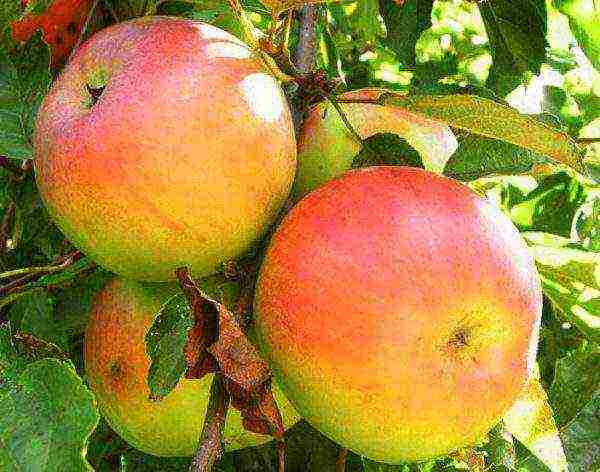
Apples of the Imrus variety are large, yellow in color with a reddish blush
- Lobo. The variety is medium late, the fruits are harvested at the end of October. The apples are sweet and sour, juicy, raspberry-purple in color, covered with a dense waxy coating. Fruit weight varies from 100 to 180 g. The variety perfectly tolerates transportation, zoned for the Central Black Earth Region of Russia.
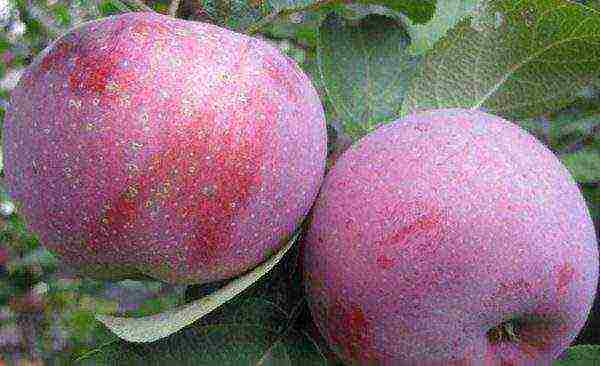
Lobo apples are easily recognizable by their rich crimson color with "rime" (wax bloom)
- Antonovka is ordinary. A high-yielding variety of late ripening, characterized by increased frost resistance. Grows well near groundwater. Fruits weigh from 100 to 125 g. The pulp is dense and juicy, the taste is sweet and sour. More than 20 varieties of apple trees have been created on the basis of Antonovka.
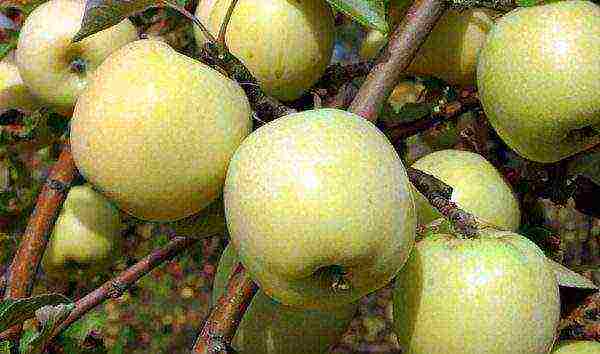
Antonovka is loved in Russia and the CIS: the sweet and sour taste of these yellowish green apples reminds of childhood, because in the past this variety was very popular in the USSR.
Breeding novelties
Recently, breeders have been working tirelessly to create new fruit trees. They do not need to be grafted onto a dwarf stock, they are natural dwarfs, more compact than their predecessors. The fruits of natural low-growing apple trees are large in size. The creation of new varieties takes time, but breeders can already please us with the following options:
- Moscow necklace;
- Autumn striped;
- Grounded;
- Carpet;
- Snowdrop.
Some of these varieties are zoned, others can be grown on the territory of Russia, Belarus, Ukraine and in other regions.
Gardeners reviews
The creation of full-fledged dwarf apple trees has been worrying breeders for a long time. The main goal of the experiments is still the formation of a miniature tree with large fruits and high yields. Perhaps, in the near future, breeders will be able to develop a variety that will become ideal for most gardeners.
Photographer, copywriter. Work experience 8 years. Knowledge of English, German.
